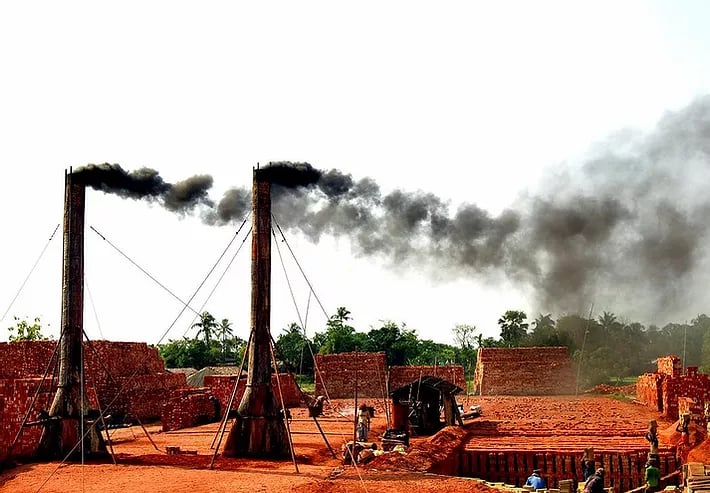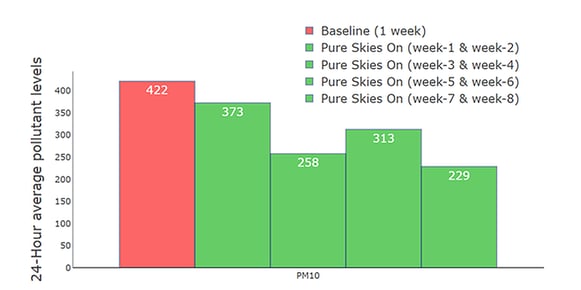Air cleaners for educational institutions
Case Study: Pure Skies for for educational institutions

What we did:
A university in north Delhi was facing high levels of air pollution on its campus due to several industrial areas nearby, as well as numerous brick kilns in the area. Pure Skies reduced levels of particulate pollution - PM10 by 46%.
The problem:
Universities should be temples of learning, where students seek higher knowledge

PC:theprint.net
However, some educational institutions have more than coronavirus-induced distance learning to contend with – air pollution in and around the campus poses a health hazard to students, faculty, and support staff.
One of Devic Earth’s customers, a major university in north Delhi, was having difficulty with high levels of ambient air pollution. The campus was adjacent to a major highway and was less than a kilometer from two large industrial zones. To add to their air quality woes, hundreds of brick kilns catering to Delhi’s construction industry were within a 15 km radius – and none of these used the latest protocols for reducing kiln emissions.

Brick kilns in rural India often lack basic air pollution control technology such as zig-zag chimneys can spew large amounts of soot and particle pollutants into the atmosphere. PC:live.staticflickr.com
Levels of PM10 – particulate matter of 10 microns in diameter, recorded by Devic Earth over a 1 week period in December 2019– was 422μg/m3,more than four times higher than the limits of the National Ambient Air Quality (NAAQ) standards (PM10 < 100 μg/m3). In other words,
The students and faculty on this college campus were breathing toxic air every day.
The solution:
One Pure Skies outdoor air cleaner was installed on the university campus, on the rooftop of an administration building. The system was configured to handle particulate pollutants (PM10 and PM2.5) and common pollutant gases such as nitrogen oxides and sulfur oxides.

PC: www.reuters.com
To quantify air pollution levels and understand trends at the campus, air quality monitoring was performed for a period of 7-days (baseline period) prior to Pure Skies being powered on, then continuously thereafter.
Pollutant levels were monitored using a third-party air quality monitor (Oizom Pvt Ltd.) to help the customer understand the efficacy of Pure Skies, as well as to provide real time data for optimizing the smart technology in each Pure Skies unit. Oizom certifies their air quality monitors for accuracy by an independent third party prior to use. The air quality monitor was installed on the rooftop of one of the classroom buildings about 200 m from the Pure Skies pollution control unit.
Devic Earth monitors the performance of each unit 24x7. Pure Skies' built in smart technology allows each unit to understand air quality patterns at its location.
Technical requirements included only routine power supply (ordinary 10A sockets) and just 2 sq. ft. of floor space for Pure Skies, and wall or pole mounting for the air quality monitor. Equipment was plugged in and connected to the local GSM data network.
The facilities manager and engineering head were given secure logins to view their property’s air quality data on a convenient app.
The outcome:
During the baseline, the 24-hour average levels of particle pollutants - PM10 were very high: 422±184 μg/m3.
After Pure Skies was powered On, a steady improvement was observed in the air quality(Figure 1).
With Pure Skies on, levels of PM10 reduced by 46%.
In comparison, levels of PM10 at the nearest reference monitor operated by the CPCB remained steady during this time.

Average pollutant levels and % reduction at the University, Sonipet. The red and green bars are the Pure Skies-Off(7-days) and Pure Skies-On periods (14-days), respectively. The successive green bars depict the incremental decrease in the levels of the pollutants over 7-day intervals. Data source: 3rd party air quality monitor (Oizom Pvt. Ltd.), pre-calibrated against a reference grade monitor and certified for accuracy.
